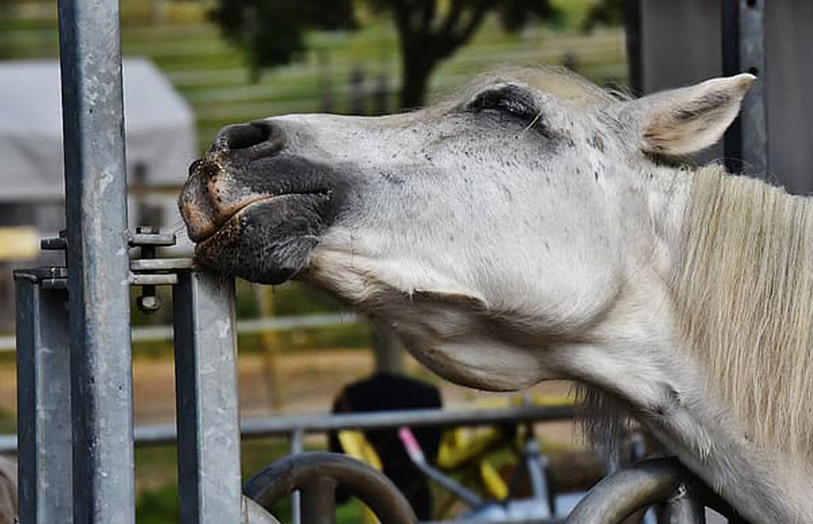
Are You & Your Horse Ready For Bitting Advice? The Steps You Need To Consider First
Equestrian Advice & Guides All Disciplines
Build your business profile for FREE and expose your services to thousands of potential clients!
Create my profile now!
Like any mammal with hair, horses can become infested with lice. These lice are not dissimilar to the types found on humans and other animals. The treatment, however, is different, but with sufficient knowledge, equine lice can be treated pretty easily.
There are different horse lice treatments available all year round. But, before you begin to treat your horse for lice, it is vitally important that you know how to diagnose them on a horse.
Horse lice are tiny parasites that live on the skin and in the fur of horses, and tend to be more common in horses that are stressed; often as a result of injury, poor health or inadequate nutrition.
 There are two main types of horse-specific louse that can be found in the UK and they can be split into two categories; the sucking louse (Haematopinus asini) and the biting louse (Damalinia equi / Bovicola equi). The rarer sucking variety ingest the horse’s blood and tissue fluid, and generally appear in areas of longer hair such as the mane, tail, and fetlocks. This type of louse is more damaging to the overall health of the horse, as even mild infestations often lead to anemia caused by blood loss, which in young horses can cause weakness or stunted growth. The biting variety feed on skin debris and are typically found in shorter-haired areas, most frequently around the neck, flanks, and dock (base of the tail). These are far more common than the sucking kind, and despite causing a lesser decline in the horse’s overall condition, they can often cause them greater distress and irritation, especially those with sensitive skin.
There are two main types of horse-specific louse that can be found in the UK and they can be split into two categories; the sucking louse (Haematopinus asini) and the biting louse (Damalinia equi / Bovicola equi). The rarer sucking variety ingest the horse’s blood and tissue fluid, and generally appear in areas of longer hair such as the mane, tail, and fetlocks. This type of louse is more damaging to the overall health of the horse, as even mild infestations often lead to anemia caused by blood loss, which in young horses can cause weakness or stunted growth. The biting variety feed on skin debris and are typically found in shorter-haired areas, most frequently around the neck, flanks, and dock (base of the tail). These are far more common than the sucking kind, and despite causing a lesser decline in the horse’s overall condition, they can often cause them greater distress and irritation, especially those with sensitive skin.
There are several telltale signs to look out for that can indicate the presence of horse lice. These are some of the most common symptoms;
Condition - By far the most common indicator is that the horse's coat will likely look dull and unkempt. Flaky skin, patches of absent hair on the neck or shoulders, or raw skin may also suggest that the condition is present. Matted hair in the mane, tail or body is another common sign of horse lice.
Health - Lice struggle to survive on healthy adult horses and are most common on horses with a weak immune system; if they are sick, old or young. However, when large numbers of horses are kept together, lice can affect even the healthiest individuals. Decreased muscle tone is one of the less obvious symptoms, as is anaemia, which will require a blood sample for diagnosis. This could also be identified by regularly weighing your horse.
Behaviour - Behavioural symptoms, such as intense itching causing them to scratch, bite or rub their skin against fences, walls or anything they can access, is another indicator of lice infestation. This can lead to the patchy coat and raw skin, as mentioned above.
Visual Inspection - Not all horses will have an obvious physical or behavioural reaction to lice, but although they are small, luckily they can usually be seen by the naked eye in the horse’s coat. They tend to live close to the base of the hairs and can look a bit like dandruff; they are more likely to come to the surface when the horse sweats. On closer inspection, you may also be able to see their tiny eggs (nits) in the fur.
Your horse can also suffer from 'mange', a disease that develops from the presence of mites. They are commonly found on the surface of agricultural animals such as horses, sheep, cattle and other livestock. Mites cause infestation of the skin which can look similar to the symptoms of lice, but are too small to be seen with the naked eye and will need a vet to diagnose them properly by examining skin scrapings under the microscope. For more information about mites and mange, see our article Diagnosing And Treating Horse Mites (Mange).

Lice infestation can occur all year round, but is a more common problem in cool, moist climates, making late winter to early spring a prime time in the UK. The cooler and skin and longer hair conditions are more favourable to reproduction. Another contributing factor is that horses are more often kept inside during the colder months, and lice thrive in crowded, indoor conditions.
Whatever the time of year, if you think your horse may have lice, a thorough inspection could go a long way to help confirm your suspicions. Check all the places outlined above, where it is common to find lice on a horse. Using good light, part the hair and search for eggs or the bodies themselves. The eggs (or nits) are oval shaped and pale white-ish in colour, and will be attached to the hair, near the skin. The lice themselves have flat, wingless bodies, and can be anywhere between 1.5 - 5mm in length. They can vary in colour from light brown to yellow to grey, depending on the species and age of the louse, and can therefore be harder to identify in lighter coloured coats.
Damalinia, although more common, are much smaller and gather in fewer numbers, meaning a careful, prolonged inspection (potentially with a magnifying glass) will be needed to spot them. They do, however, tend to move around a lot more than Haematopinus. In the case of Haematopinus, both the eggs and lice should be visible to the naked eye. It can often be helpful to brush the horse’s hair downward into a container using a stiff brush, in order to collect the lice for easier inspection.
If, after an inspection, you have found the presence of lice, or even if you are still unsure, contact a vet as they will be able to correctly diagnose the infection, rule out any other possible conditions, and outline the correct course of treatment. There are also some easy, natural treatments that can prove very effective.
Once you have diagnosed the lice in your horse, it is vital that you begin to treat it straight away. Blood sucking horse lice (Haematopinus asini) can be killed with oral ivermectin or moxidectin, administered by your vet in 2 to 3 doses at two week intervals. However this will not work on chewing lice. Do not be tempted to use treatments intended for use on human lice, or that of any other species. These will not work. Always consult your vet for advice on the best course of treatment.
There are plenty of topical treatments available for treating biting lice (Damalinia equi / Bovicola equi), most of which contain ingredients such as permethrin and cypermethrin, which have proven to be effective at killing the larvae and adult lice. Whatever treatment you choose, it will need to be repeated several times to ensure that any unhatched nits are killed once hatched. Nits can take up to 3 or 4 weeks to hatch and develop into adult lice.
Possible treatments for biting lice include permethrin-based washes, shampoos, lotions, powders or sprays, that are suitable for use on horses. Lotions, sprays and powders that can be brushed through the coat can be particularly helpful when the weather is too cold to allow bathing. Always use treatments as instructed by the manufacturer, following the instructions on the container, and be sure to avoid any areas of sore or broken skin during application.
Follow treatment of your horse with thorough cleaning of any potentially infected tack, bedding, rugs, grooming equipment etc, to avoid reinfestation from the surrounding environment. Wash blankets on a high temperature setting to kill the lice more effectively. Repeat this each time you repeat the treatment on the horse.
While there are a number of very effective chemical and insecticidal products available for the treatment of horse lice, you may wish to try something a bit more natural, in which case we can recommend the following alternatives;
There may be other natural home remedies that prove effective, but if you don't have success the first time, you might have to persevere with a bit of trial and error to get something that works for you.
While treating the affected horse or horses will go some way to ridding them of the lice infestation, there are some extra measures that can be taken to prevent the problem in the first place, or at the least, reduce the chances of reinfestation;

Treating lice can require time and effort, but hopefully this guide has been a helpful resource. By following the advice given, you should be able to get the problem under control fairly quickly and be ready to take the correct preventative measures to reduce the chances of reinfestation.

